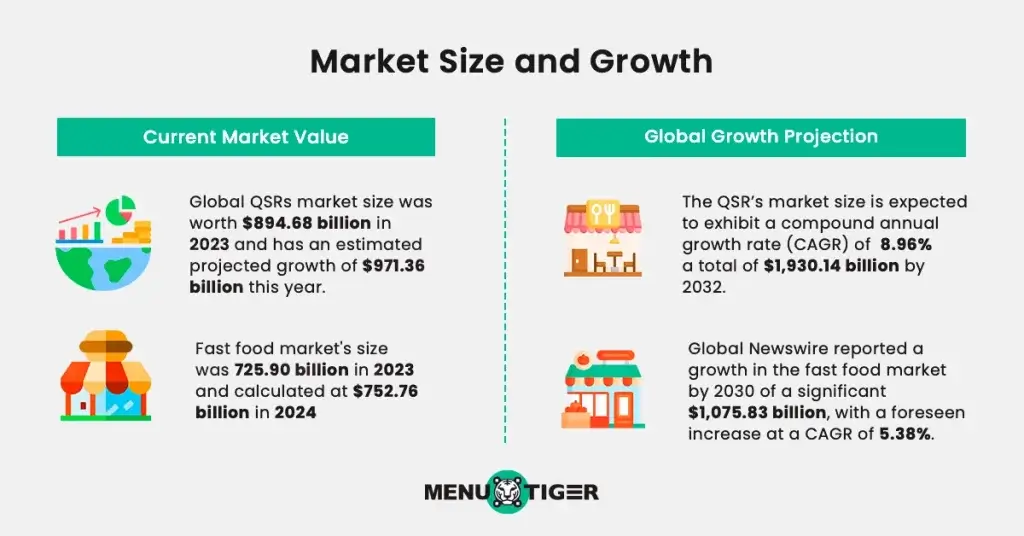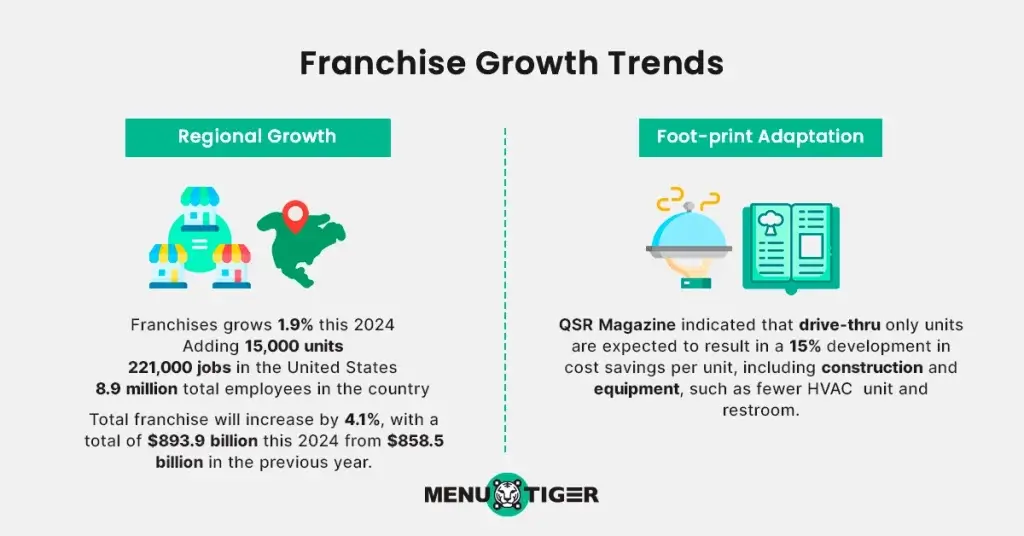Thinking about becoming your own boss but worried about the cost? You’re not alone!
It can really feel overwhelming, especially when it comes to finances. But, with the right eye for opportunities, you can start with the cheapest franchise to open in 2025.
From a pizza hub down to cuisine-inspired restos, you can make it possible without breaking the bank.
This blog presents a curated list of diverse franchises with unique business models and restaurant order management systems and tools to help you secure a return on investment immediately.
Table of Contents
ToggleData check: How are fast-food franchises doing in the market?
Before heading straight to franchising, it’s important to know the numbers to assess if it’s a potential hit or miss.
Take a look at the data gathered on how fast-food and other quick-service restaurants (QSR) are doing:
Market size and growth

- Current market value
Fortune Business Insights reported that the global QSRs market size was worth $894.68 billion in 2023 and has an estimated projected growth of $971.36 billion this year.
Additionally, Precedence Research reports that the fast food market’s size was 725.90 billion in 2023 and calculated at $752.76 billion in 2024.
One big player in this market was the three-year global pandemic, which shifted consumers’ dining habits. Fast yet safe service was in demand to deliver food to homes.
- Global growth projection
The QSR’s market size is expected to reach $1,930.14 billion by 2032, exhibiting a compound annual growth rate (CAGR) of 8.96 percent.
This is driven by the increasing consumer preference for dining in quick-service restaurants.
On the other hand, Global Newswire revealed a significant $1,075.83 billion growth in the fast food market by 2030, with a foreseen increase at a 5.38 percent CAGR.
It says that globalization and urbanization have influenced people’s eating habits and propelled them to consume fancy, high-calorie fast food, which is convenient and easy to eat.
Franchise growth trends

- Regional growth
New data from the International Franchise Organization (IFA) in their franchise economic outlook showed exceeded growth despite the ongoing economic uncertainty.
On top of the 2.2 percent growth in 2023, the report forecasted franchises to grow an additional 1.9 percent this 2024, adding 15,000 units and 221,000 jobs in the United States, bringing a total of 8.9 million total employees in the country.
The total franchise output will increase by 4.1 percent, with a sum of $893.9 billion this 2024 from $858.5 billion in the previous year.
- Foot-print adaptation
QSR Magazine indicated that drive-thru-only units are expected to result in a 15 percent development in cost savings per unit, including construction and equipment, such as fewer Heating, Ventilation, and Air Conditioning (HVAC) unit and restroom.
This reduced seating models to lower real estate and operational costs.
Technology innovation

- Self-ordering kiosks
Self-service kiosk statistics showed that 65 percent of QSR customers prefer the convenience of kiosk-based ordering, propelling the market towards a projected value of $30 billion.
The pursuit of speed and efficiency rapidly shapes consumer habits, which is an important characteristic of the quick-service sector.
- Delivery and online ordering
The pandemic was indeed a transformative breakthrough that emphasized convenience and accessibility in the industry.
According to Statista, online food delivery generated a total revenue of $1.20 trillion in 2024 alone and is projected to exhibit a CAGR of 9.04 percent in 2029, resulting in a total of $1.85 trillion.
This is due to its capacity to widen its demographic reach, which has increased its sales massively.
Top 20 cheapest restaurant franchises to open for your new business venture
When starting a franchise, many new owners are also finishing degrees or professional certifications. Relying on a research paper writer can ease the academic workload, allowing them to fully focus on financial planning and business growth.
Now that you’re all set with the important figures, it’s time to explore the cheapest franchises for you to start, which offer a low-cost franchise option, perfectly suited to your financial capacity and ensuring positive returns on your investments.
Here’s a list of affordable franchises to choose from:
Chester’s Chicken
This family-owned quick service restaurant has more than 1,200 active locations, is best known for its crispy fried chicken.
What’s even more interesting is its unique business model. It operates in gas stations and convenience stores, serving a broad customer base.
Although the brand has developed its reputation, the investment required is relatively low, which has attracted many entrepreneurs.
SharpSheets, a franchise consultation firm, says the initial investment cost is between $28,000 and $297,000, with an average revenue of $322,000 per year.
This already includes the cost of construction, equipment, inventory, and initial operating expenses. But the total amount depends on the feature you’re applying.
Here are various features Chester’s Chicken offers:
- Store-in-Store (500+ square feet)
This is a popular option within a maximized, in-line format, including a six-foot merchandiser (counter space) and a three-panel digital menu board.
- Full Dining Room (500+ square feet)
This extension of Chester’s into a dining room provides a more immersive experience. The package includes another six-foot merchandiser, a three-panel digital menu board, and source materials for tables, chairs, service counters, walls, etc.
- Express (400 + square feet)
Promotes Chester’s within a small footprint that maximizes limited space using a four-foot merchandiser and two-panel digital board.
- Grab-N-Go (4 square feet)
It features a hot case that maintains product holding temperature and features sandwiches for additional sales.
Expert’s note: Unlike other franchise restaurants and fast-food chains, Chester’s Chicken does not have royalty fees, so you get the whole percentage of your revenue.
Firehouse Subs
Founded by former firefighter brothers in 1994, this sandwich chain has opened more than 1,000 franchises in 44 states, Puerto Rico, and Canada.
While booming as a business, they’ve managed to build a foundation, which attracted many entrepreneurs.
If you’re interested, they’re offering an initial investment of around $150,000, with a net-worth requirement of $300,000, the cheapest franchise to open in your area.
The initial franchise fee, according to Top Franchise, is $20,000. Additionally, there’s a lower royalty fee, which is six percent of your gross sale.
Franchisees also need to contribute three percent towards national advertising.
This lower fee structure, combined with the brand’s strong recognition and community involvement, helps keep ongoing costs manageable.
Thanks to that, Firehouse Subs generates about $800,000 to $900,000 in annual revenue, and franchises can expect a net profit of around $108,000 to $140,000 per annum.
Baskin Robins
If you’re interested in serving ice cream in your area, consider this world-leading franchise, which has 6,000 outlets in 35 countries.
The initial investment they offered ranged from $94,00 to $400,00, with a franchise fee of $25,000 for a 20-year term.
If you’re going to apply, you need to have a net worth of $200,000 and liquid assets of $100,000.
The good news here is, for those developing locations, Baskin-Robins offers incentives, such as reduced franchise fees up to $12,500 and a five-year reduction in royalty fees starting at zero percent in your year one.
Cold Stone Creamery
This cherished ice cream brand is celebrated for its high-quality hand-made ice cream, with a record of nearly a thousand franchisees.
To open one, it offers two initial investment ranges as per the Franchise Paycheck record.
The cost of a traditional store ranges from $322,675 to $627,775. This includes the franchise fee of $12,000 to $27,000, equipment costs, and other start-up expenses.
The cost of a nontraditional setup ranges from $57,000 to $484,275. A royalty fee of six percent of gross sales is also charged.
The franchise package offers support for franchisees with ample training and marketing, guiding them through the building of their franchise, from site selection and construction to social media engagement and promotions.
In the US, the average annual gross sales are about $600,000. However, figures can vary depending on your location.
Paris Banh Mi
This Vietnamese sandwich shop is a head-turner. It combines the perfectly toasted Paris Baguette with Vietnamese dishes.
This can be a perfect starting point if you’re looking to offer cultural diversity in your business.
Franchise Now stated the initial franchise fee is manageable at $60,000, with the total investment between $200,000 to $500,000.
This amount reflects the option of acquiring a preexisting, equipped location for a lower investment cost or completely building out from scratch.
Cinnabon
Cinnabon presents one of the most successful franchise opportunities in the dessert sector.
It’s known for its iconic cinnamon trolls and various business models, such as full bakeries, express bakeries, and concession units, that can accommodate different investment levels.
The estimated investment based on Franchise Direct would range from $254,750 to $674,400. It also requires royalty fees for all business models with 6% net sales and an additional contribution for ads, which is about two to three percent.
With an average profit margin of 15 percent, the franchisees are expected to recoup their initial investment within about seven years.
Hissho Sushi
If you’re looking for Asian restaurants to franchise, check out the Hissho Sushi franchise opportunity.
With its high-quality, freshly made sushi and other Asian-inspired cuisine, they’re able to expand to more than 2,000 franchise units since 1901.
According to Franchise Business Review records, to open one, you need to invest between $25,550 and $128,750, depending on the location and set-up.
The franchising fee is around $10,000 to $15,000, which is quite competitive within the sushi franchise market.
The company provides comprehensive training that covers operational and marketing aspects, including food safety, making it a good option for those new to the cuisine.
ACE sushi
Another sushi franchise to consider is ACE Sushi, which operates in non-traditional venues like grocery stores, universities, and hospitals.
The franchise has been around since 2005, and its business model allows franchisees to cater to customers who seek fresh, quality sushi for carryout or quick consumption.
Franchise Disclosure Document (FDD) Exchange has provided a detailed information on its total investment:
- $18,275 to $124,375 for a Main Sushi Bar;
- $19,775 to $129,375 for a Main Sushi Bar with a Satellite Location or
- $20,775 to $229,375 if you purchase an existing Ace Sushi Bar from the franchisor.
These amounts include:
- $12,575 to $107,475, which must be paid to the Franchisor or an affiliate for a Main Sushi Bar;
- $14,075 to $112,475, which must be paid to the Franchisor or an affiliate for a Main Sushi Bar with a Satellite Location or
- $15,075 to $212,475, which must be paid to the Franchisor or an affiliate if you purchase an existing Ace Sushi Bar from the franchisor.
Taco Bell
If you’re planning to go to a Mexican-inspired cuisine, Taco Bell, a subsidiary of Yum! Brand, Inc., is the perfect choice.
With a total of 7,197 franchises and an Average Revenue of $1,049,000 per year, you are assured of a significant net profit.
As disclosed by SharpSheets, the initial investment depends on the unit type you’re going for. A new traditional unit would cost $1,584,750 to $3,980,200, and a new in-line or end cap ranges from $610,750 to $1,440,200.
Take note that the amount still varies, depending on the location and whether you choose to lease or purchase a property.
With its median gross sales per location of $2.1 million, you can expect potential earnings in the range of $250,000 in Earnings Before Interest, Depreciation, and Amortization (EBITDA).
Chick-fil-A
Chick-fil-A is a popular choice among franchise restaurants with relatively low initial investment compared to other restaurant chains.
According to Nerdwallet Finance Company, the franchise fee costs around $10,000, which is significantly lower than McDonald’s and Wendy’s.
Additionally, Franchise Direct estimates the total initial investment to range from $444,243 to $2,338,786.
It includes the initial franchise fee, opening inventory, first month’s rental of equipment, restaurant insurance expense, and other additional funds.
Papa John’s Pizza
This American Pizza restaurant chain is a good starter if you’re still testing the waters in franchising.
Papa John’s has 5,800 locations globally and an average revenue of $1.1 million per annum, which you can leverage through ROI using its brand popularity.
The total initial investment required ranges from $188,615 to $975,415, including the franchise fee of $25,000.
The company offers four distinct features in its franchise package:
- Prime white space available
Their modern design, Papa John’s Epic Dough, allows Papa John’s to thrive in every kind of location in the US. They will assist you in choosing a prime area to grow in, as there is a lot of white space throughout the country.
- Support and training
Franchisees receive comprehensive training programs and procedures, including initial restaurant operations training, development solutions, and introduction of new equipment and products.
- Innovation
They provide various advanced solutions and developments at all levels: product, consumer marketing, technology, restaurant order system and customer experience to benefit the franchisee’s bottom line.
- Commitment to Quality
Ensures fresh, never-frozen doughs are highlighted in the efforts to consistently deliver superior service.
Ben & Jerry’s
Beating the heat in the summer with your first ice cream franchise can definitely bring you massive off-the-chart sales.
Ben & Jerry’s startup costs can vary depending on where, when, and what you’ve decided to open.
Here’s a rough cost breakdown:
- Full-size shop (750 to 1200 square feet) = $237,800 to $549,300
- In-line shop (450 to 650 square feet) = $250,800 to $384, 800
- Kiosks (100 to 200 square feet) = $155, 900 to $331,800
These include the three-month operating expenses and a franchise fee of $39,500 (traditional) and $18,000 (special venue).
The royalty fee is up to five percent in net gross sales and is subject to change upon the notice of the parent brand.
Jimmy John’s
Like other successful franchise restaurants, Jimmy John’s business model is all about speed. They serve their guests within 30 seconds using an impressive prep system perfected over the past three decades.
This submarine sandwich franchise has a record of 2,800 locations with a reported ROI of $907,848.
1851 Franchise highlighted the cost to get in, ranging from $356,200 to $674,200.
This covers startup costs like real estate, construction, and equipment needed for it to be fully functional.
The franchise fee is typically around $35,000, and you’ll need a minimum of $200,000 in liquid capital to quality.
The royalty and other additional fees required are around ten percent of gross sales, but based on the average revenue acquired every year, they are expected to return in earnings.
Sbarro
For those interested in fast-casual pizza restaurants, Sbarro offers a compelling opportunity to bring New York-style pizza and Italian-American cuisine to your place.
Pizza Franchise Hub cited that starting a Sbarro franchise involves several financial commitments, primarily the franchising fee, ranging from $25,000 to $35,000.
Its initial investment starts from $350,000 to $650,000, covering costs such as real estate, construction, equipment inventor, and working capital.
Franchisees are also required to pay a royalty fee of five percent of their gross sales to support ongoing training and access to the restaurant’s operating systems.
Subway
Subway is one of the most affordable fast-food franchises in the fast-food industry, with 37,000 franchise units, making this popular for entrepreneurs.
The Franchise Deck review revealed that the franchise fee is $15,000, and the overall franchise cost is between $229,050 and $522,300.
However, the royalty fee is around eight percent with an additional fee for food advertisements of 4.5 percent.
It will also require you with a net worth of $150,000 and a cash of $100,000.
Dunkin’ Donuts
Dunkin’ Donuts offers a competitive franchise opportunity that will surely appeal to first-time business owners entering the QSR.
According to Franchise Empire, starting a Dunkin’ franchise requires an upfront investment of $121,400 to $1,787,700.
Because the parent company allows franchisees to choose the location, the cost varies much.
If you’re looking for a traditional store format, you need to pay a franchise fee ranging from $40,000 to $90,000.
Additionally, the ongoing fees vary between two to six percent plus the five percent for advertising.
Checkers & Rally’s
This is another fast-food chain that focuses primarily on drive-thru services.
It specializes in burgers, fries, and other quick-service items, perfect for busy people around the area.
According to their records, as of 2023, they had a total of 834 units (franchised and owned).
If you’re into this type of restaurant, the initial investment would range from $169,000 to $2,126,000.
The company also requires an initial fee of $30,000, followed by a royalty fee of four percent of the net gross sales and 4.5 percent for advertising.
To qualify, you need to have liquid capital of $250,000 and a net worth of at least $750,000.
Domino’s Pizza
Domino’s Pizza is the second-largest pizza business in the world, with 18,486 branches on six continents.
To get a franchise, an interested franchisee needs to start with a minimum of $75,000 in liquid cash and a net worth of at least $250,000.
The initial investment depends on the location and the type of franchise you want to open.
For a traditional location, this can range from $144,1450 to $582,500. The franchising fee for building a new Domino’s pizza store is around $25,000.
Additional fees, like royalty and marketing, total 9.5 percent of your net gross sales.
But a guarantee of ROI is secured, the average EBITDA of franchisees earns above revenue of 12.1 percent, which means a franchise owner can take at most $144,000 of profit.
Wingstop
Adding to your chicken menu fast-food chain is Wingstop, which provides a compelling franchise opportunity for entrepreneurs.
With almost 2,000 locations in the US and recent expansion into France, this popular fast-food chain’s unique flavors and decor signify its growing global appearance.
In Franchise Empire’s research, opening one requires a significant investment between $347,600 and $759,100, with ongoing fees for royalties, marketing, and local advertising.
This is because interested franchise owners must undergo extensive training, including online courses, classroom instruction, and hands-on experience, to maintain high-quality service and consistency of the food.
Because of this consistency, they have reached an average franchise revenue of $1,592,657, indicating potential profitability.
Little Caesars
Another world-renowned pizza hub you might want to start your business with is Little Caesars.
The chain has established a global presence with over 5,000 locations across various countries, making it the 3rd largest pizza restaurant in the world.
So, to open your own Little Caesars, you’ll need to make an initial investment from $393,000 to $1.7 million.
This includes various expenses, such as the franchise fee of $20,000, build-out costs, and equipment.
The company also requires a financial requirement of liquid capital of around $200,000 and a net worth of $400,000.
But you can expect a median gross sales of around $900,000 with owner-operator earnings averaging about $150,000 annually.

Tips for selecting the right franchise
Align with your interests and strengths
Choose a franchise that excites you and compliments your skills well.
If your passion leans toward fast food, then find a concept you’ll enjoy managing day-to-day.
Consider assessing your strengths in customer service, operations, or marketing to help you excel in your franchise business.
Assess the technology and systems of these affordable franchises
Investigate the restaurant technology tools the franchise offers, such as the POS system, restaurant order management tools, CRM software, and digital marketing platforms.
Pick a franchise that has the most user-friendly, up-to-date technology that simplifies operations and customer management.
It’s a great addition if they offer online ordering and automation to streamline processes.
Evaluate the franchise fees and financial health
Don’t hesitate to compare initial franchise fees, royalties, and technology investments with your budget.
This is to help you decide whether it suits your target or not.
Additionally, financial accuracy is crucial when assessing franchise expenses, payroll, and revenue. Using a reliable paystub generator can help entrepreneurs manage employee payments and ensure proper record-keeping as they scale their businesses.
Also, ensure that the franchise has a clear financial model and solid ROI potential, considering both upfront and ongoing costs.
By maintaining consistent financial tracking, franchise owners can better forecast cash flow needs and make informed budgeting decisions.
Tools that help them manage employee payments also reduce administrative burdens, allowing more time to focus on growth strategies, operational efficiency, and long-term sustainability within a competitive franchise environment.
Upgrading your franchise restaurant with a QR code menu technology
QSRs are known for their speed and efficient services, and their technologies streamline the workflow.
How about adding a restaurant technology like MENU TIGER to advance your daily operations even more?

Here is a list of benefits you can get:
- Digital menu with QR code
There’s no need for customers to get into the hassle of lining up, be it at your counter or kiosk.
Once a QR code is scanned, they can access your menu, where they can order and pay directly using their mobile phones.
- Marketing tools
This technology provides restaurant marketing tools to help you in your marketing efforts, from a personalized website to your promotions, doubling up your marketing efforts from your parent company’s ads.
Here, you can align your promos and special deals with your customers’ preferences and purchasing capacity, while also leveraging effective online lead generation strategies to attract and convert more potential diners.
- Extensive integrations
Customer management, designing tools, and even POS systems are set to serve as this smart menu provides various digital tools ready to assist you in making streamlined processes.

Franchise on a dime: Secure big success with small investments
There’s no doubt that starting a business, particularly a restaurant, can cost you two pockets.
But that does not mean you can’t own that dream and turn that passion into profit. Start by franchising.
There are many cheapest franchises to open where you can start your dream business without having to think about the system, menu, marketing, etc.
All you need to do is to be wise enough in choosing them: Do they align with your interests? Do they have advanced restaurant order management tools and other technologies? Do they build a profound financial model?
This way, you get the most out of every penny you invest.
So, don’t be afraid to start small. Eventually, you get to finish big.
FAQs
This is a business model that requires minimal experience, training, and operational complexity, which makes it easier for entrepreneurs to start and manage.
These franchises typically have streamlined processes, lower investment requirements, and offer strong support from the franchisor.
Fast-food franchises are often considered ideal for beginners because they offer a proven business model with streamlined operations.
The systems in place for inventory management, staffing, and menu preparation are well-established, making it easier for new franchisees to follow a set formula.
Additionally, brand recognition in fast food is a significant advantage, as it attracts customers without the need for heavy local marketing.





